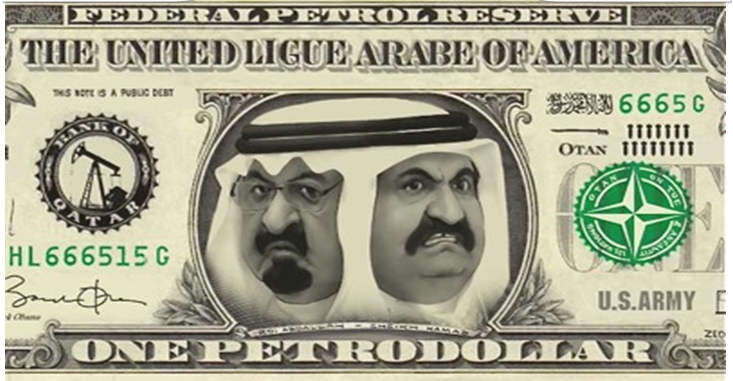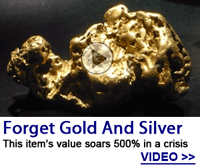 By James Hall
By James Hall
Establishment economists are the first vindicators that having a weak currency is essential to foster international trade. The utter absurdity that a nation can prosper when their coin of the realm buys less is inherently illogical. Yet, for the globalists, maintaining the myth that promoting exports in a system that is designed around transporting our domestic manufacturing capacity overseas is intellectually incongruent. So what is the essential argument for having a strong currency?
If you are an economic nationalist, you will agree with Stephan Smith, when he acknowledges in “How a Strong Currency Affects an Economy”
There is really only one advantage to having a strong currency and that advantage isn’t usually felt buying goods and services where parts and components are obtained, manufactured and sold all in one country. It takes international trade and the use of different currencies to be able to feel the benefit. The primary benefit of a strong currency is to be able to get foreign goods and services at lower prices. That’s it.
Now if you disagree that this objective is the rational objective, you are in need of serious reflection if you have lost your mind. At the outset, all fiat currencies are based upon the power of implemented confidence or imposed exchange limits. Floating rates have little to do with free markets. Currencies are a measure of national policy and globalist objectives. So when the U.S. Dollar is favored with reserve currency status, it is based upon the Bretton Woods dictates that America was the World War II victor.
Much has changed since that era. The world economy has become a petroleum-based environment. Reflecting this reality has the 10 Most Expensive Currencies in 2016 disproportionately represented by several oil rich minor countries.
As of January 19, 2016, the most expensive currency in 2016 is not the U.S. dollar, the British pound, or the euro. Surprisingly, the most valuable currencies in the world don’t always belong to the wealthiest economies.
The following list of currencies gives the U.S. dollar a run for its money when it comes to the most expensive currency in the world. All exchange rates are as of January 19, 2016.
- Kuwaiti Dinar (KWD) One Kuwaiti dinar buys US$3.28
- Bahraini Dinar (BHD) One Bahraini dinar buys US$2.65
- Omani Rial (OMR) One Omani rial buys US$2.60
- British Pound (GBP) One British pound buys US$1.42
- Euro (EUR) One euro buys US$1.09
- Swiss Franc (CHF) One Swiss franc buys US$0.99
- Libyan Dinar (LYD) One Libyan dinar buys US$0.74
- Bruneian Dollar (BND) One Bruneian dollar buys US$0.70
- Singapore Dollar (SGD) One Singapore dollar buys US$0.70
- Australian Dollar (AUD) One Australian dollar buys US$0.69
Half of the currencies on this list may be a surprise to most. Without the reliance upon oil, what exactly would these Arab notes be worth? However, just having a favorable exchange rate does not necessarily guarantee access to all the goods and services that would normally be associated with affluence.
While, many Arab states have developed the most modern infrastructures on the planet, their oil assets do not ensure that their wealth is secured going forward. As the American war machine deploys into the region, so goes the risk and downfall for regimes that no long provide a favorable advantage against the latest villain that is targeted for removal.
Erik Townsend is quoted in “Prepare for the Death of the Petrodollar,”
The petrodollar system breaking down, where oil is no longer paid for in dollars internationally, essentially would be the death knell to the U.S. dollar as the reserve currency. It means the U.S. can’t borrow with ‘exorbitant privilege’ anymore, and it means the U.S. Treasury market is set for an out-of-control interest rate spiral.
The elimination of Saddam Hussein and Muammar Gaddafi had much to do with their intentions and plans to dump the dollar as payment for their black gold. While both failed to produce a lasting alternative, the economics of the depressed price of oil, in dollars; has created other alliances.
Most notably, “Russia and China: The Dawning of a New Monetary System?” asks if the major powers can precipitate the final demise of American hegemony.
The US is able to maintain pressure on other currencies, currently the ruble, only as long as the petro dollar remains the major world reserve currency. This is the main reason why Washington gets away with a seven-fold indebted dollar (i.e. total outstanding and uncovered commitments are currently more than 7 times higher than the US GDP (US$ 17.6 trillion, 2014 est. – vs. US$ 128 trillion of unmet obligations); making the US worldwide the most indebted country – by far.
While the fall of the U.S. Dollar does not seem imminent, the empirical reality of paper debt obligations is inescapable. Yet, the important point is that recent history has indicated that these insurmountable financial obligations just do not matter very much when it comes to a soaring dollar.
Melissa Parietti contends in “The 6 Strongest Currencies Vs. The U.S. Dollar in 2016″ that,
The Fed’s recent federal funds rate increase to 0.25% is an indicator of future strength for the U.S. dollar. As it stands, U.S. currency has one of the strongest exchange rates in the world. After the fall of euro over the past two to three years, the dollar has made additional gains over the yuan and the yen. This may position the dollar for more future gains against these currencies.
 What kind of upside-down world exists in exchange rate trading pits? For that answer, examine the methods and schemes used by the central banksters for controlling the financial wealth of the major geopolitical players.
What kind of upside-down world exists in exchange rate trading pits? For that answer, examine the methods and schemes used by the central banksters for controlling the financial wealth of the major geopolitical players.
For in the end, the settlement on all currencies has more to do with power politics than fundamental economics. Bretton Woods did not establish a market based floating rate monetary system, but did create a New World Order central banking manipulation cartel. Odds are this plot will only mutate into a newer version of the age old money changers exchange.
Original article archived here
James Hall is a reformed, former political operative. This pundit’s formal instruction in History, Philosophy and Political Science served as training for activism, on the staff of several politicians and in many campaigns. A believer in authentic Public Service, independent business interests were pursued in the private sector. Speculation in markets, and international business investments, allowed for extensive travel and a world view for commerce. Hall is the publisher of BREAKING ALL THE RULES. Contact batr@batr.org

GodDam the evil usury world banker zio Rothchild petro dollar
All this article is saying is that the US dollar is in fact worthless!
Regarding fundamental economics, talk of a Petro Yuan new currency hegemon blossoming from a China-Russia alliance doesn’t make a whole lot of sense either in the current oil = money system. Russia’s proven oil reserves are estimated at 80 billion barrels (bbl) compared, for example, to Saudi at 268, Iran 157, Iraq 140, and the lower quality crude oils of Venezuela 298 and Canada 175, OPEC ~1200 bbl, with world total ~1482 bbl. 80 bbl is a modest amount for a very large land mass (Russia) being funneled to China with it’s population of 1.4 billion.
What’s really going to upend the petrodollar apple cart is the UN 2030 Agenda, cloaked in a green mask with it’s plans to phase out oil use and herd the masses into tiny urban hovels. Bloomberg reported a few years ago the Saudis asked UN reps for assurances they would receive financial assistance(!) to support their people once the 2030 rules kick in and their income from oil takes a nosedive. They know what’s coming, and so does Ottmar Edenhofer who was an IPCC co-chair for seven years until 2015, and Christiana Figueres. http://www.investors.com/politics/editorials/another-climate-alarmist-admits-real-motive-behind-warming-scare/
“Another Climate Alarmist Admits Real Motive Behind Warming Scare” –
Edenhofer: “One has to free oneself from the illusion that international climate policy is environmental policy. This has almost nothing to do with the environmental policy anymore, with problems such as deforestation or the ozone hole,”
So what is the goal of environmental policy?
“We redistribute de facto the world’s wealth by climate policy,”
The Sauds seem to be fighting with oil gluts to send the USA frackers packing.
Germany is closing all their nuclear power plants and replacing them with renewable energy (wind, biogas, solar). We can too. And honestly, I totally don’t care what happens to the economy of the oil rich Arab countries. They have the audacity not to take one single Muslim refugee, letting Europe take the whole hit! It’s time we stop doing business with them, giving them our dollars to build their extremely extravagant luxury cities!